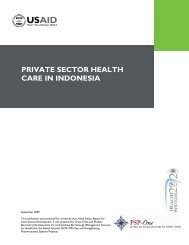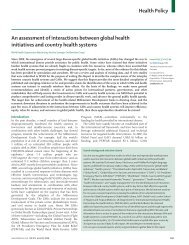Building Health Management Information Systems in Egypt - PHRplus
Building Health Management Information Systems in Egypt - PHRplus
Building Health Management Information Systems in Egypt - PHRplus
Create successful ePaper yourself
Turn your PDF publications into a flip-book with our unique Google optimized e-Paper software.
4.0 MIS Conceptual Framework<br />
Exist<strong>in</strong>g <strong>in</strong>formation systems fall <strong>in</strong>to two major categories, facility management systems<br />
and hierarchical <strong>in</strong>formation systems. Follow<strong>in</strong>g sections describe the general characteristics of<br />
each, and how they relate to each other.<br />
4.1 Facility <strong>Management</strong> <strong>Systems</strong><br />
Facility management systems <strong>in</strong>clude database management systems commonly found <strong>in</strong><br />
large <strong>in</strong>patient facilities, such as Admission/Discharge/Transfer, Medical Records, Medical<br />
Materials Control or Drug Inventory Control, Personnel/Payroll, General Account<strong>in</strong>g, and so on.<br />
These database subsystems are often, though not always, <strong>in</strong>tegrated so that appropriate<br />
<strong>in</strong>formation is passed horizontally from one subsystem to another. Figure 2 is a simple example<br />
of how these systems are often related.<br />
4.2 Hierarchical <strong>Information</strong> <strong>Systems</strong><br />
Hierarchical <strong>in</strong>formation systems collect data at one level and pass it to a higher level,<br />
where <strong>in</strong>formation from similar units is consolidated and processed. This process may be repeated<br />
at the next level, so that <strong>in</strong>formation becomes <strong>in</strong>creas<strong>in</strong>gly consolidated as it passes up through the<br />
hierarchy until reach<strong>in</strong>g the top executive level. A pyramid, as shown <strong>in</strong> Figure 3-1, is often used<br />
to depict this k<strong>in</strong>d of system. As <strong>in</strong>dicated, <strong>in</strong>formation consumers at different levels need<br />
different k<strong>in</strong>ds of <strong>in</strong>formation presented <strong>in</strong> different ways. In a hierarchical organization with<br />
multiple management units and levels, this general concept is often replicated <strong>in</strong> tiers, as shown <strong>in</strong><br />
Figure 4. Such a system is designed to support managers and decision-makers at different levels<br />
and <strong>in</strong> different locations. There are executive decision-makers at many levels, each need<strong>in</strong>g<br />
<strong>in</strong>formation. A system meet<strong>in</strong>g these needs is not a s<strong>in</strong>gle pyramid with a s<strong>in</strong>gle apex, but a<br />
hierarchy of <strong>in</strong>formation pyramids, each serv<strong>in</strong>g decision-makers at one level while provid<strong>in</strong>g<br />
<strong>in</strong>formation for use at the next.<br />
4.3 Comb<strong>in</strong>ed <strong>Systems</strong><br />
Facility management systems are often an important component of hierarchical<br />
<strong>in</strong>formation systems. They collect data as a part of rout<strong>in</strong>e operations, provid<strong>in</strong>g essential<br />
resource consumption and performance monitor<strong>in</strong>g data as a byproduct. Implement<strong>in</strong>g these<br />
systems replaces a multitude of forms for collect<strong>in</strong>g data. Often these forms provide no value to<br />
the facility itself.<br />
Figure 5 is a simple diagram show<strong>in</strong>g a comb<strong>in</strong>ation of facility management and<br />
hierarchical <strong>in</strong>formation systems mapped to the MOHP context. It is a comb<strong>in</strong>ation of systems<br />
be<strong>in</strong>g implemented and systems be<strong>in</strong>g planned under various projects. It illustrates important<br />
concepts and issues discussed <strong>in</strong> follow<strong>in</strong>g sections.<br />
4.0 MIS Conceptual Framework 23
















